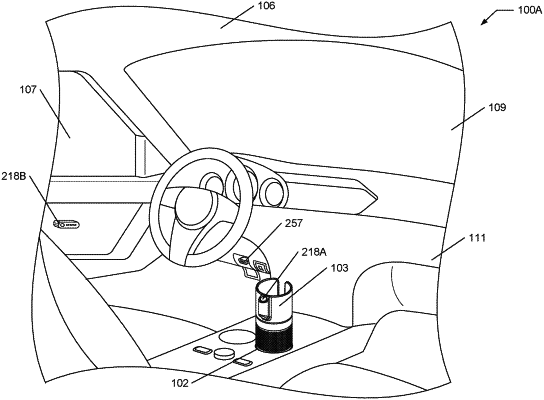| CPC B60R 25/31 (2013.01) [B60R 1/00 (2013.01); B60R 25/102 (2013.01); B60R 25/1009 (2013.01); B60R 25/305 (2013.01); B60R 25/33 (2013.01); G01V 11/002 (2013.01); G06F 21/572 (2013.01); B60R 11/00 (2013.01); B60R 25/04 (2013.01); B60R 25/1003 (2013.01); B60R 25/1004 (2013.01); B60R 25/1018 (2013.01); B60R 25/1025 (2013.01); B60R 25/24 (2013.01); B60R 25/245 (2013.01); B60R 25/25 (2013.01); B60R 25/307 (2013.01); B60R 25/32 (2013.01); B60R 25/34 (2013.01); B60R 25/403 (2013.01); B60R 25/406 (2013.01); B60R 2011/0007 (2013.01); B60R 2025/0405 (2013.01); B60R 2025/1013 (2013.01); B60R 2300/103 (2013.01); B60R 2300/8006 (2013.01); B60R 2300/8073 (2013.01); B60R 2325/10 (2013.01); B60R 2325/101 (2013.01); B60R 2325/103 (2013.01); B60R 2325/20 (2013.01); B60R 2325/205 (2013.01); G01B 17/00 (2013.01); G01J 5/0025 (2013.01); G01P 13/00 (2013.01); G06F 3/017 (2013.01); G06F 3/167 (2013.01); G06F 8/65 (2013.01); G06Q 20/102 (2013.01); G06Q 20/3278 (2013.01); G06Q 20/40145 (2013.01); G06Q 30/0635 (2013.01); G06T 7/174 (2017.01); G06T 2207/10016 (2013.01); G06V 20/59 (2022.01); G06V 40/172 (2022.01); G07C 9/00182 (2013.01); G07C 2009/0019 (2013.01); G07C 2009/00396 (2013.01); G07C 2009/00539 (2013.01); G07C 2009/00769 (2013.01); G07C 2009/00984 (2013.01); G08B 21/182 (2013.01); H04L 9/0643 (2013.01); H04L 9/0869 (2013.01); H04L 9/3231 (2013.01); H04L 51/224 (2022.05); H04L 2209/84 (2013.01); H04W 4/021 (2013.01)] | 20 Claims |

|
1. A vehicle theft-prevention apparatus, comprising:
a body comprising a first portion and a second portion, the first portion configured to rotate about the second portion to affix the body into a cup holder of a vehicle;
a plurality of sensors configured to sense measurements proximate to the vehicle;
a wireless transceiver; and
at least one computing device coupled to the plurality of sensors and the wireless transceiver, the at least one computing device configured to:
read a plurality of first measurements of a first sensor of the plurality of sensors;
determine that a key fob moved outside of a range of the first sensor based on the plurality of first measurements from the first sensor;
in response to the key fob moving outside of the range of the first sensor, transition to an armed state;
read a plurality of second measurements from a subset of the plurality of sensors;
transition to an unarmed state based on communicating with the key fob; and
in response to entering the unarmed state, disable measurements from the plurality of sensors.
|